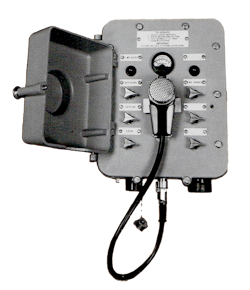Navy picks Dynalec Corp. to design battle-hardened shipboard communications for Constellation-class frigate
CHARLESTON, S.C. – U.S. Navy shipboard communications experts needed a battle-hardened telephone and announcing system for the next-generation Constellation class guided-missile frigate. They found their solution from Dynalec Corp. in Sodus, N.Y.
Officials of the Naval Information Warfare Center Atlantic in Charleston, S.C., announced a $23.9 million five-year contract to Dynalec on Monday to develop and build the Wired Voice Network (WVN) for the future Constellation-class frigate. The contract has options that could increase its value to $48 million.
The WVN will be a telephone and announcing system for vital and mission-critical end-to-end communications within the ship. The Constellation-class frigate will replace the Navy's now-retired Oliver Hazard Perry-class frigates -- the last of which, the USS Ingraham (FFG 61), was removed from service in 2014.
The WVN will provide point-to-point telephone communications between various points on the ship, as well as one-way transmission of general orders, information, and alarm signals to various locations aboard the ship where personnel are stationed or normally will be located.
The shipboard communications systems also will provide interfaces to other shipboard systems, and to shipboard connection points to the Defense Switching Network (DSN) and the Public Switched Telephone Network (PSTN).
The future USS Constellation will be the lead ship of a class of at least 20 frigates. The hull of the frigate is be based on the Italian FREMM-class frigate. The first three ships of the class are under contract to Fincantieri Marinette Marine Corp. in Marinette, Wis.
The WVN telephone system will be a reliable and survivable network with built-in redundancy to eliminate single points of failure caused by battle damage or on-board accidents.
In addition, the system will have server and node failover redundancy in case of a controlling element failure. If any controlling element fails, all established calls must stay active. Failover capability allow new calls in 30 seconds or less. After failover, all interconnections will be available with no increase in blocking.
Related: Lockheed Martin to design combat management system shipboard electronics for Navy frigate
The announcing system will provide for one-way transmission of general orders, information, and alarm signals over loudspeakers to various locations where personnel are stationed or will normally be located. Such transmissions are made by means of microphones, alarm activators, and loudspeakers connected through central controlled amplifiers.
The reliable and survivable network announcing system will handle vital and mission-critical interior shipboard communications with built-in redundancy to eliminate single points of failure.
The Constellation-class frigate will be able to keep up with Navy aircraft carriers and will have sensors networked with the rest of the fleet. It normally will be part of Navy strike groups and large surface combatant-led surface action groups, but also will be able to operate and defend itself in independent operations.
Frigates typically are escort vessels that are lighter than destroyers, and help defend aircraft carrier battle groups or merchant convoys from submarine, aircraft, and cruise missile threats. They are intended to operate in the open ocean, unlike the Navy littoral combat ship, which is designed to operate in coastal waters and harbors.
The new frigates will have a minimum of 32 Mark 41 Vertical Launch System cells aboard for anti-air warfare. The ship will be designed to destroy surface ships over the horizon; detect enemy submarines; defend convoy ships; employ active and passive electronic warfare systems; and defend against swarming small boat attacks.
Shipboard electronics will include the Lockheed Martin COMBATSS-21 combat management system; AN/SPY-6(V)3 Enterprise Air Surveillance Radar (EASR); AN/SPS-73(V)18 surface search radar; AN/SLQ-61 lightweight towed array sonar; AN/SQS-62 variable-depth sonar; AN/SQQ-89F undersea warfare and anti-submarine warfare combat system; and Cooperative Engagement Capability (CEC).
The Constellation-class frigate will be able to fire RIM-162 ESSM Block 2 and/or RIM-174 Standard ERAM missiles; RIM-66 Standard SM-2 Block 3C; the Naval Strike Missile; RIM-116 Rolling Airframe Missile; Mk 110 57-millimeter gun; and machine guns. The ship will be able to carry one MH-60R Seahawk helicopter and the MQ-8C Firescout unmanned helicopter.
The Constellation and its first two sister ships, the USS Congress (FFG 63) and USS Chesapeake (FFG 64) are named for three of the Navy's six original frigates -- USS Chesapeake; USS Constitution; USS President; USS United States; USS Congress; and USS Constellation -- built between 1797 and 1800. Of these original ships, the USS Constitution still is a Navy commissioned warship and is based in Boston.
Dynalec designs and builds military-grade systems to withstand the rigors of the military shipboard environment that involves extremes in shock, vibration, temperature, humidity, and acoustic noise. The company designs equipment racks and cabinets, subassemblies, or complete systems for shipboard communication, navigation, and switching applications.
Dynalec specializes in EMI-resistant enclosures and cabinets; shock- and vibration-proof equipment; fire detection sensors and control systems; sound powered telephone systems; analog, digital, and IP-based voice systems, terminals, telephones, intercoms, and announcing systems; synchro and servo devices; and ship control and navigation systems.
On this contract Dynalec will do the work in Sodus, N.Y., and Marinette, Wis., and should be finished by March 2028. For more information contact Dynalec Corp. online at www.dynalec.com, Fincantieri Marinette Marine Corp. at https://fincantierimarinegroup.com, or the Naval Information Warfare Center Atlantic in Charleston, S.C. at www.niwcatlantic.navy.mil.

John Keller | Editor-in-Chief
John Keller is the Editor-in-Chief, Military & Aerospace Electronics Magazine--provides extensive coverage and analysis of enabling electronics and optoelectronic technologies in military, space and commercial aviation applications. John has been a member of the Military & Aerospace Electronics staff since 1989 and chief editor since 1995.


